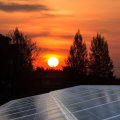China— 32% United States— 16% Japan— 9% India— 7% Germany— 6%.
solar
energy, radiation from the Sun capable of producing heat, causing chemical reactions or generating electricity. The total amount of solar energy incident on Earth far exceeds the world's current and anticipated energy needs. If properly harnessed, this highly diffuse source has the potential to meet all future energy needs.In the 21st century, solar energy is expected to become increasingly attractive as a renewable energy source due to its inexhaustible supply and non-polluting nature, in stark contrast to finite fossil fuels, coal, oil and natural gas. The vast majority of photovoltaic products, or solar panels, are being installed in remote areas by giant solar parks that sell energy to utilities. Satellite images show the incredible growth of these huge solar parks that continue to appear across China.
Solar energy
is the transformation of heat, the energy that comes from the sun.It has been used for thousands of years in many different ways by people all over the world. The oldest uses of solar energy are for heating, cooking and drying. Nowadays, it is also used to produce electricity where there are no other power sources, such as in places far from where people live and in outer space. In addition, the solar industry is a proven incubator for employment growth across the country.
U.S. solar jobs have increased 167% in the past decade, which is five times faster than the overall rate of employment growth in the U.S. UU. There are more than 250,000 solar workers in the United States in fields spanning manufacturing, installation, project development, trading, distribution and more.
Solar energy has not reached its full potential as a clean energy source for the United States, and much remains to be done to drive the deployment of solar technologies. Solar hardware costs have been drastically reduced, but market barriers and grid integration challenges continue to hinder further. The “soft costs” of non-hardware solar energy, such as permits, financing and customer acquisition, are becoming a growing fraction of the total cost of solar energy and now account for up to 65% of the cost of a residential photovoltaic system. Technological advancements and innovative market solutions continue to be needed to increase efficiency, reduce costs and allow utilities to rely on solar energy for baseload energy.
Read the latest on the solar energy market in the Quarterly Solar Industry Update from the National Renewable Energy Laboratory. Learn more about the goals set by the U.S. Department of Solar Energy's Office of Solar Energy Technologies (SETO) to drive innovation and cost reduction. Download the Solar Future Study Report.
Learn more about SETO, its areas of research and how solar energy works. Forrestal Building 1000 Independence Avenue, SW Washington, DC 20585. The most commonly used solar technologies for homes and businesses are photovoltaic solar energy for electricity, passive solar design for space heating and cooling, and solar water heating. Solar cells are combined into an arrangement called a solar cell panel that can supply enough electricity for practical use. The solar cooker uses the Sun as an energy source instead of standard cooking fuels, such as coal, coal or gas.
China leads the way for installed photovoltaics, with the United States and Japan in second and third place in terms of installed solar capacity, respectively. Solar energy is a powerful source of energy that can be used to heat, cool and illuminate homes and businesses. Solar radiation produced by the sun's energy is abundant all over the world, but some places are more suitable for photovoltaic solar panels than others. Photovoltaic panels usually include solar panels, a collection of dozens or even hundreds of solar cells.
It is based on insolation in different parts of the Earth's surface, which is a measure of the amount of solar radiation reaching an area. The United States has continued to improve its position as a leader in solar energy by expanding its facilities in the utility sector and the residential market. As one of the most densely populated countries in the world, Japan cannot afford to cover huge tracts of land with solar panels. Of course, these factors alone cannot predict the solar production potential of an individual installation.
Some of the countries with the most sunlight are on the list of the top 10 solar capacity systems, such as Australia and India, but there is certainly untapped potential in Africa and South America. Solar cookers also allow villagers to devote themselves to education, business, health or family during the time that was previously used to collect firewood. Solar ponds are sometimes used to produce electricity by using the Rankine cycle organic engine, a relatively efficient and economical means of converting solar energy, which is especially useful in remote locations. Typical uses of solar space heating systems include powering radiant floors or pairing with a forced warm air (FHA) system to heat a home.
. .







